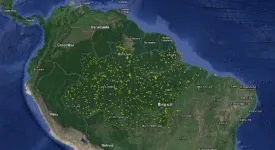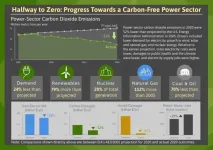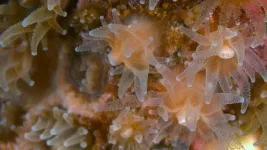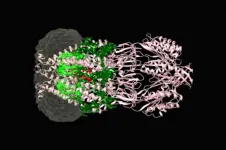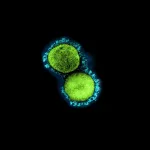(Press-News.org) A group of researchers led by Brazilians has used an innovative model to map gaps in the Amazon rainforest and identify factors that contribute to tree mortality. Water stress, soil fertility, and anthropic forest degradation have the most influence on gap dynamics in the world's largest and most biodiverse tropical rainforest, according to an article on the study published in Scientific Reports.
Forest gaps are most frequent in the areas with the highest levels of soil fertility, possibly because the abundance of organic material drives faster tree growth and shorter life cycles.
The main method of data collection used in the study was LiDAR (light detection and ranging), a remote sensing method that uses pulsed laser light. Coverage extended to remote parts of the Brazilian Amazon where fieldwork is very difficult and satellite images can be imprecise, owing mainly to heavy cloud.
An airborne LiDAR system emits thousands or hundreds of thousands of laser light pulses, which bounce off Earth's surface and return to the system at the speed of light, enabling the height of trees and other objects to be determined on the basis of the lag between emission and reception of the pulses. Resolution can be as high as 1 meter, so LiDAR is used to survey topography and the structure of vegetation, often in the form of a 3D scan.
"The western and southeastern parts of Amazonia had the most gaps, closest to the 'arc of deforestation' on the agricultural frontier. Forest dynamics are up to 35% faster there than in the center-east and north, with more gap creation and tree mortality," Ricardo Dal'Agnol, first author of the article, told Agência FAPESP. Dal'Agnol is an environmental engineer working as a researcher in the Earth Observation & Geoinformatics Division of Brazil's National Space Research Institute (INPE).
In the study, which was supported by FAPESP, the scientists used a database resulting from more than 600 flights over the forest as part of INPE's Amazon Biomass Estimation Project (EBA), led by Jean Ometto, a senior researcher at INPE and a co-author of the article.
The purpose of the EBA was to quantify biomass and carbon in the Amazon and explore the dynamics of vegetation in the region. The maps produced by INPE as part of the project can be used to formulate public policy, facilitate the inventorying of emissions, and estimate carbon balances.
Carbon sequestration
Forests, above all tropical forests, are considered the largest biological reservoir of biomass and carbon on the planet. Trees need large amounts of CO2 to develop and grow. Changes in forest functioning and tree mortality therefore significantly influence the amount of greenhouse gas emissions into the atmosphere. They also directly affect the market for carbon credits currently being implemented in several countries following regulation by the Paris Agreement, a major global environmental policy milestone.
In 2019, greenhouse gas emissions in Brazil rose 9.6% compared with the previous year, largely owing to deforestation in the Amazon. In that year, Brazil pumped 2.17 billion gross tonnes of carbon dioxide equivalent (tCO2e) into the atmosphere, up from 1.98 billion tCO2e in 2018, reversing the downtrend seen in previous years, according to a report by Brazil's Greenhouse Gas Emission and Removal Estimating System (SEEG).
"The uncertainties associated with tree mortality drivers and mechanisms, especially at smaller scales ( END
Airborne laser scanning of gaps in Amazon rainforest helps explain tree mortality
The researchers concluded that water stress, soil fertility and human-induced forest degradation cause gaps in the world's largest tropical forest
2021-04-13
ELSE PRESS RELEASES FROM THIS DATE:
Giant electronic conductivity change driven by artificial switch of crystal dimensionality
2021-04-13
The electronic properties of solid materials are highly dependent on crystal structures and their dimensionalities (i.e., whether the crystals have predominantly 2D or 3D structures). As Professor Takayoshi Katase of Tokyo Institute of Technology notes, this fact has an important corollary: "If the crystal structure dimensionality can be switched reversibly in the same material, a drastic property change may be controllable." This insight led Prof. Katase and his research team at Tokyo Institute of Technology, in partnership with collaborators at Osaka University and National Institute for Materials Science, to embark on research into the possibility of switching the crystal structure dimensionality of a lead-tin-selenide alloy semiconductor. Their results appear in a paper published ...
Smoking cannabis significantly impairs vision, study finds
2021-04-13
A study carried out by the University of Granada indicates that smoking cannabis significantly alters key visual functions, such as visual acuity, contrast sensitivity, three-dimensional vision (stereopsis), the ability to focus, and glare sensitivity
Yet, more than 90% of users believe that using cannabis has no effect on their vision, or only a slight effect
A group of researchers from the Department of Optics of the University of Granada (UGR) has studied the effects of smoking cannabis on various visual parameters compared to the effect that the users themselves perceive the drug to have on their vision.
This study, led by Carolina Ortiz Herrera and Rosario González Anera, has been published in the journal Scientific Reports. Its main author, Sonia Ortiz Peregrina, explains that ...
US power sector is halfway to zero carbon emissions
2021-04-13
Concerns about climate change are driving a growing number of states, utilities, and corporations to set the goal of zeroing out power-sector carbon emissions. To date 17 states plus Washington, D.C. and Puerto Rico have adopted laws or executive orders to achieve 100% carbon-free electricity in the next couple of decades. Additionally, 46 U.S. utilities have pledged to go carbon free no later than 2050. Altogether, these goals cover about half of the U.S. population and economy.
These are ambitious targets, but a new look at the past 15 years in the electricity sector shows that large reductions in emissions are possible.
New research from the Department of Energy's Lawrence ...
Northern Star Coral study could help protect tropical corals
2021-04-13
As the Rhode Island legislature considers designating the Northern Star Coral an official state emblem, researchers are finding that studying this local creature's recovery from a laboratory-induced stressor could help better understand how to protect endangered tropical corals.
A new study published today in mSystems, a journal of the American Society for Microbiology, investigates antibiotic-induced disturbance of the coral (Astrangia poculata) and shows that antibiotic exposure significantly altered the composition of the coral's mucus bacterial microbiome, but that all the treated corals recovered ...
Study of US tuna fisheries explores nexus of climate change, sustainable seafood
2021-04-13
A new study published in Elementa by researchers at the University of California, Santa Cruz and NOAA examines traditional aspects of seafood sustainability alongside greenhouse gas emissions to better understand the "carbon footprint" of U.S. tuna fisheries.
Fisheries in the United States are among the best managed in the world, thanks to ongoing efforts to fish selectively, end overfishing, and rebuild fish stocks. But climate change could bring dramatic changes in the marine environment that threaten seafood productivity and sustainability. That's one reason why researchers ...
Researchers develop new method for putting quantum correlations to the test
2021-04-13
Physicists from Swansea University are part of an international research collaboration which has identified a new technique for testing the quality of quantum correlations.
Quantum computers run their algorithms on large quantum systems of many parts, called qubits, by creating quantum correlations across all of them. It is important to verify that the actual computation procedures lead to quantum correlations of desired quality.
However, carrying out these checks is resource-intensive as the number of tests required grows exponentially with the number of qubits involved.
Researchers from the College of Science, working with colleagues from Spain ...
Novel guidelines help select optimal deconvolution method
2021-04-13
Biomedical scientists are increasingly using deconvolution methods, those used to computationally analyze the composition of complex mixtures of cells. One of their challenges is to select one method that is appropriate for their experimental conditions among nearly 50 available.
To help with method selection, researchers at Baylor College of Medicine and the Jan and Dan Duncan Neurological Research Institute at Texas Children's Hospital have extensively evaluated 11 deconvolution methods that are based on RNA-sequencing (RNA-seq) data analysis, determining each method's ...
Inside the protein channel that keeps bacteria alive
2021-04-13
Almost all bacteria rely on the same emergency valves--protein channels that pop open under pressure, releasing a deluge of cell contents. It is a last-ditch effort, a failsafe that prevents bacteria from exploding and dying when stretched to the limit. If we understood how those protein channels worked, antibiotic drugs could be designed to open them on demand, draining a bacterium of its nutrients by exploiting a floodgate common to many species.
But these channels are tricky to operate in the lab. And how precisely they open and close, passing through a sub-conducting state and ending in a desensitized state under the influence of mechanical forces, remains poorly understood. Now, new research from ...
COVID-19 in our dust may help predict outbreaks, study finds
2021-04-13
A study done in rooms where COVID-19 patients were isolated shows that the virus's RNA - part of the genetic material inside a virus - can persist up to a month in dust.
The study did not evaluate whether dust can transmit the virus to humans. It could, however, offer another option for monitoring COVID-19 outbreaks in specific buildings, including nursing homes, offices or schools.
Karen Dannemiller, senior author of the study, has experience studying dust and its relationship to potential hazards like mold and microbes.
"When the pandemic started, we really wanted to find a way that we could help ...
NIH experts discuss post-acute COVID-19
2021-04-13
WHAT:
Many people who have COVID-19 make a full recovery and return to their baseline state of health; however, some people have symptoms or other sequelae weeks or months after initial SARS-CoV-2 infection. These heterogeneous symptoms were the subject of the virtual "Workshop on Post-acute Sequelae of COVID-19" hosted on Dec. 2 and 4, 2020, by the National Institute of Allergy and Infectious Diseases (NIAID), in collaboration with other institutes and centers of the National Institutes of Health. A paper published recently in Annals of Internal Medicine ...
LAST 30 PRESS RELEASES:
Anthropologist documents how women and shepherds historically reduced wildfire risk in Central Italy
Living at higher altitudes in India linked to increased risk of childhood stunting
Scientists discover a new signaling pathway and design a novel drug for liver fibrosis
High-precision blood glucose level prediction achieved by few-molecule reservoir computing
The importance of communicating to the public during a pandemic, and the personal risk it can lead to
Improving health communication to save lives during epidemics
Antimicrobial-resistant hospital infections remain at least 12% above pre-pandemic levels, major US study finds
German study finds antibiotic use in patients hospitalised with COVID-19 appears to have no beneficial effect on clinical outcomes
Targeting specific protein regions offers a new treatment approach in medulloblastoma
$2.7 million grant to explore hypoxia’s impact on blood stem cells
Cardiovascular societies propel plans forward for a new American Board of Cardiovascular Medicine
Hebrew SeniorLife selected for nationwide collaborative to accelerate system-wide spread of age-friendly care for older adults
New tool helps identify babies at high-risk for RSV
Reno/Sparks selected to be part of Urban Heat Mapping Campaign
Advance in the treatment of acute heart failure identified
AGS honors Dr. Rainier P. Soriano with Dennis W. Jahnigen Memorial Award at #AGS24 for proven excellence in geriatrics education
New offshore wind turbines can take away energy from existing ones
Unprecedented research probes the relationship between sleep and memory in napping babies and young children
Job losses help explain increase in drug deaths among Black Americans
Nationwide, 32 local schools win NFL PLAY 60 grants for physical activity
Exposure to noise – even while in the egg – impairs bird development and fitness
Vitamin D availability enhances antitumor microbes in mice
Conservation actions have improved the state of biodiversity worldwide
Corporate emission targets are incompatible with global climate goals
Vitamin D alters mouse gut bacteria to give better cancer immunity
Escape the vapes: scientists call for global shift to curb consumer use of disposable technologies
First-of-its-kind study definitively shows that conservation actions are effective at halting and reversing biodiversity loss
A shortcut for drug discovery
Food in sight? The liver is ready!
Climate change could become the main driver of biodiversity decline by mid-century
[Press-News.org] Airborne laser scanning of gaps in Amazon rainforest helps explain tree mortalityThe researchers concluded that water stress, soil fertility and human-induced forest degradation cause gaps in the world's largest tropical forest
